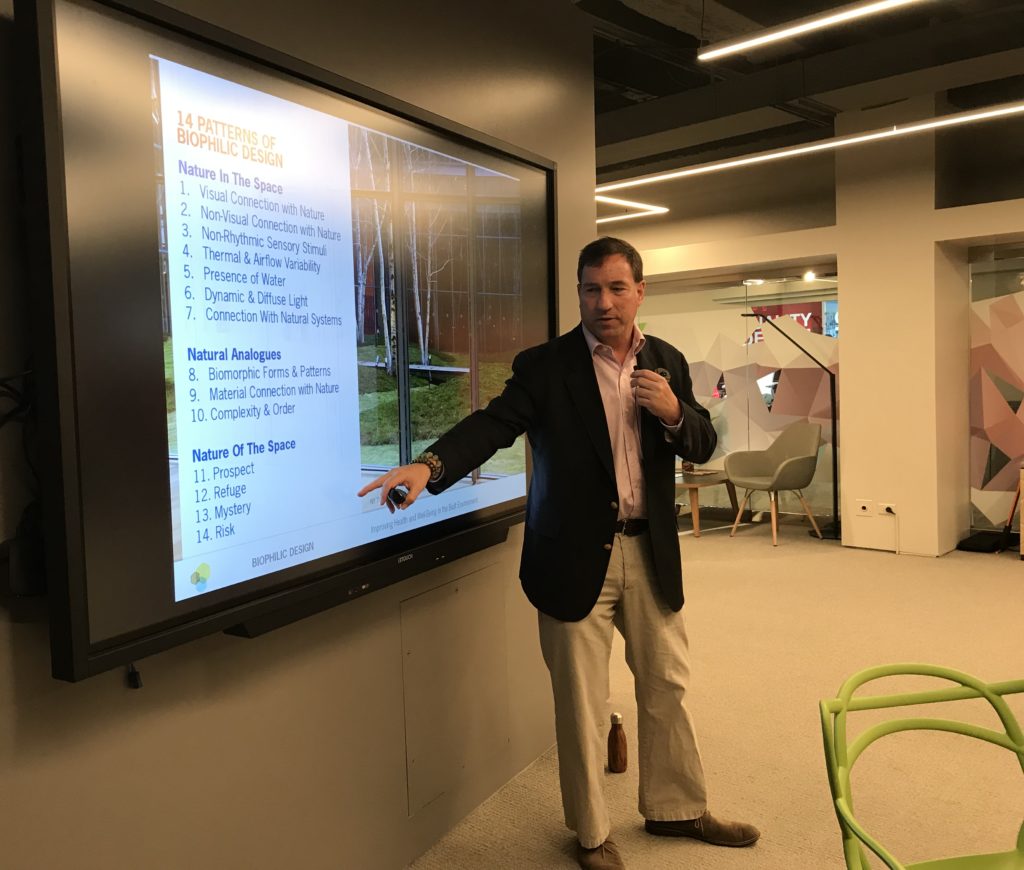

News
Recap: Bill Browning at NeoCon 2018
Dakota Walker
Share
Bill has returned from an exciting couple days at the 50th annual NeoCon in Chicago, where hundred of companies from across the commercial design sector gathered to showcase new products and share their design philosophies.
One of this year’s themes was modular refuge spaces. These spaces provide shelter and privacy in locations where we can become overstimulated (offices, schools, airports, etc.). Like any other designed product, their outcomes were of varying effectiveness. While some captured the underlying tenets of refuge: back protected, overhead canopy, soothing materials, and privacy screening, others fell into the pitfall of too much glass and sterile-feeling surfaces, translating into an experience of feeling both exposed and claustrophobic.
As for presentations, Bill Browning teamed up alongside David Gerson of Inscape to explored Non-Rhythmic Sensory Stimuli, one of Terrapin’s 14 Patterns of Biophilic Design. This pattern emphasizes  unpredictable sounds, movement, or even fragrance in our experience of nature. It has been shown to elicit a powerful response from both our brains and body chemistry. Enacted by breeze-rustled leaves, or sunlight reflecting off moving water, the effect can be a spellbinding moment of intrigue, contemplation, and mental restoration. The presentation provided interest for all, touching on everything from underlying evolutionary biology and neuroscientific studies, to applications in contemporary art and architecture.
unpredictable sounds, movement, or even fragrance in our experience of nature. It has been shown to elicit a powerful response from both our brains and body chemistry. Enacted by breeze-rustled leaves, or sunlight reflecting off moving water, the effect can be a spellbinding moment of intrigue, contemplation, and mental restoration. The presentation provided interest for all, touching on everything from underlying evolutionary biology and neuroscientific studies, to applications in contemporary art and architecture.
In addition to his main speaking event, Bill gave 4 mini-presentations at the Inscape space exploring particular biophilic design patterns as they relate to the commercial design industry. Here are a few key takeaways from those exciting presentations:
Attention Restoration Theory: Why should I be distracted at work?
- Focusing on a single task can be a demanding process for the brain.
- Resulting mental fatigue makes for a stressed, unproductive workforce.
- Brief distractions, like that caused by moving leaves out of the corner of your eye, can help restore attention and improve productivity.
- A portion of the prefrontal cortex quiets down when viewing nature and subsequently allows for better cognitive performance once back on task.
Fractals: I want brain candy.
- Fractals occur throughout nature from cauliflower to tree branches
- These mathematically-derived patterns exemplifies a balance between complexity and order that captivates our interest.
- Evidence suggests that our brain invokes a strong pleasure response when viewing these types of pattern.
- This partially explains why we’re so fascinated by campfires and breaking waves, both are moving fractals
Psychoacoustics: What am I hearing?
- While acoustics focuses on sound transmission to the ear, psychoacoustics looks at our prioritization of sounds to focus upon.
- Given the importance of water for survival, it would make sense that we are particularly attuned to and relaxed by water sounds
- Several studies have found significant cognitive improvements in participants who were played running water sounds during the testing period.
- These insights can be leveraged to inform effective acoustic design to help reduce noise distraction and improve occupant satisfaction.
Refuge: Why it’s important in our modern society and how can it be accomplished?
- Offices increasingly emphasize open-plan design and collaborative experiences, often at the expense of those cozy, private spaces where one can focus and feel safe.
- In a refuge condition, your back and neck are protected and in some cases include a lowered canopy overhead.
- Refuge spaces allow individuals to drop their guard, filter their senses, and focus on a single task.
- Refuge-inspired furniture is a popular post-design intervention to create these restorative conditions.
Dakota Walker
Dakota Walker is an Associate Project Manager & Research Analyst at Terrapin Bright Green. He recently graduated summa cum laude from the University of North Carolina Asheville with a degree in Environmental Management and Policy. Dakota believes the genius of nature has yet to be matched by human innovation. He’s interested in finding new approaches to solving contemporary policy and design challenges that reflect the resilience and resourcefulness of natural systems.
Topics
- Environmental Values
- Speaking
- LEED
- Terrapin Team
- Phoebe
- Community Development
- Greenbuild
- Technology
- Biophilic Design Interactive
- Catie Ryan
- Spanish
- Hebrew
- French
- Portuguese
- Publications
- Occupant Comfort
- Materials Science
- Conference
- Psychoacoustics
- Education
- Workshop
- Mass Timber
- Transit
- Carbon Strategy
- connection with natural materials
- interior design
- inspirational hero
- biophilia
- economics of biophilia
- Sustainability
- wood
- case studies
- Systems Integration
- Biophilic Design
- Commercial
- Net Zero
- Resorts & Hospitality
- Energy Utilization
- Water Management
- Corporations and Institutions
- Institutional
- Ecosystem Science
- Green Guidelines
- Profitability
- Climate Resiliency
- Health & Wellbeing
- Indoor Environmental Quality
- Building Performance
- Bioinspired Innovation
- Biodiversity
- Residential
- Master Planning
- Architects and Designers
- Developers and Building Owners
- Governments and NGOs
- Urban Design
- Product Development
- Original Research
- Manufacturing
- Industrial Ecology
- Resource Management
- Sustainability Plans
- Health Care
- Carbon Neutrality


